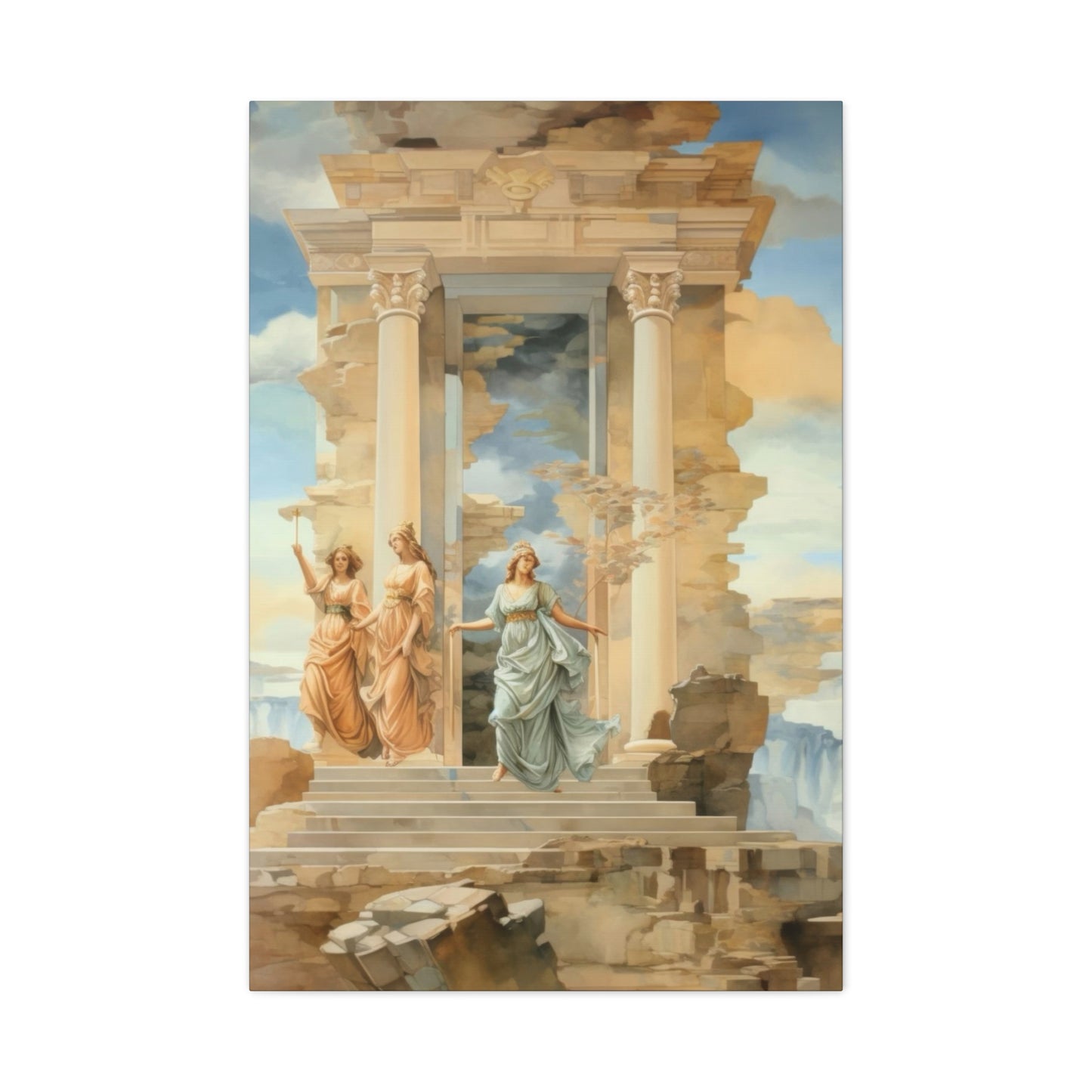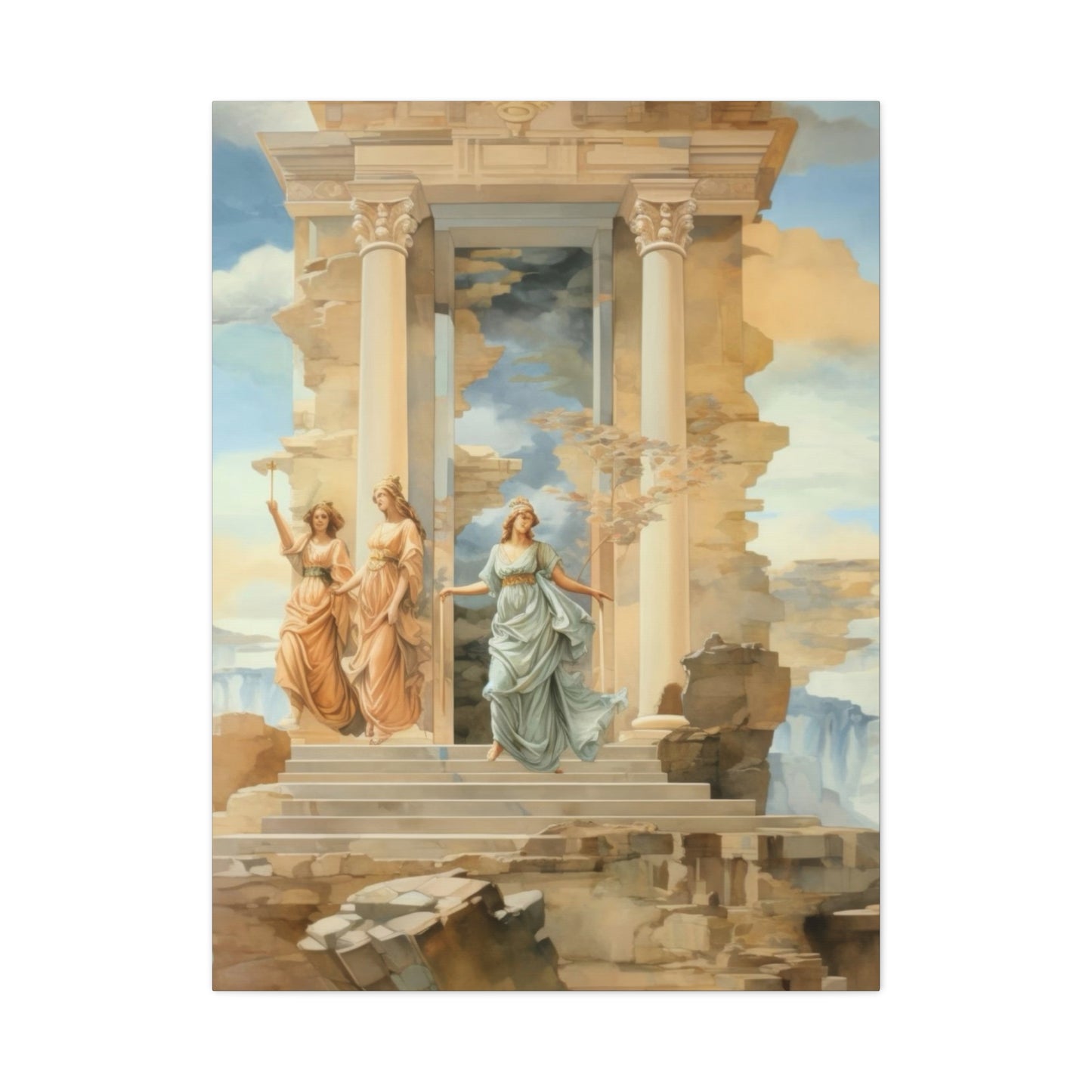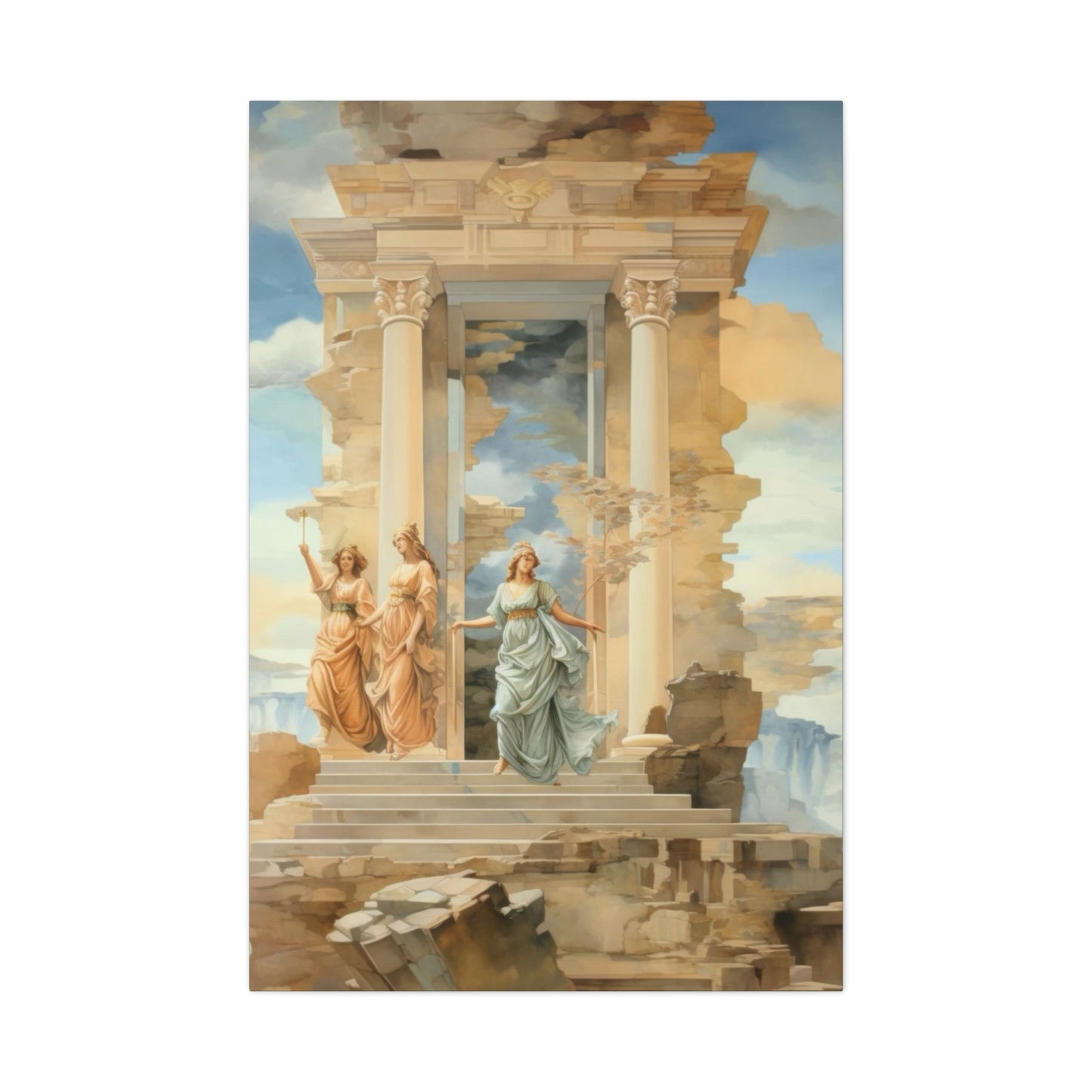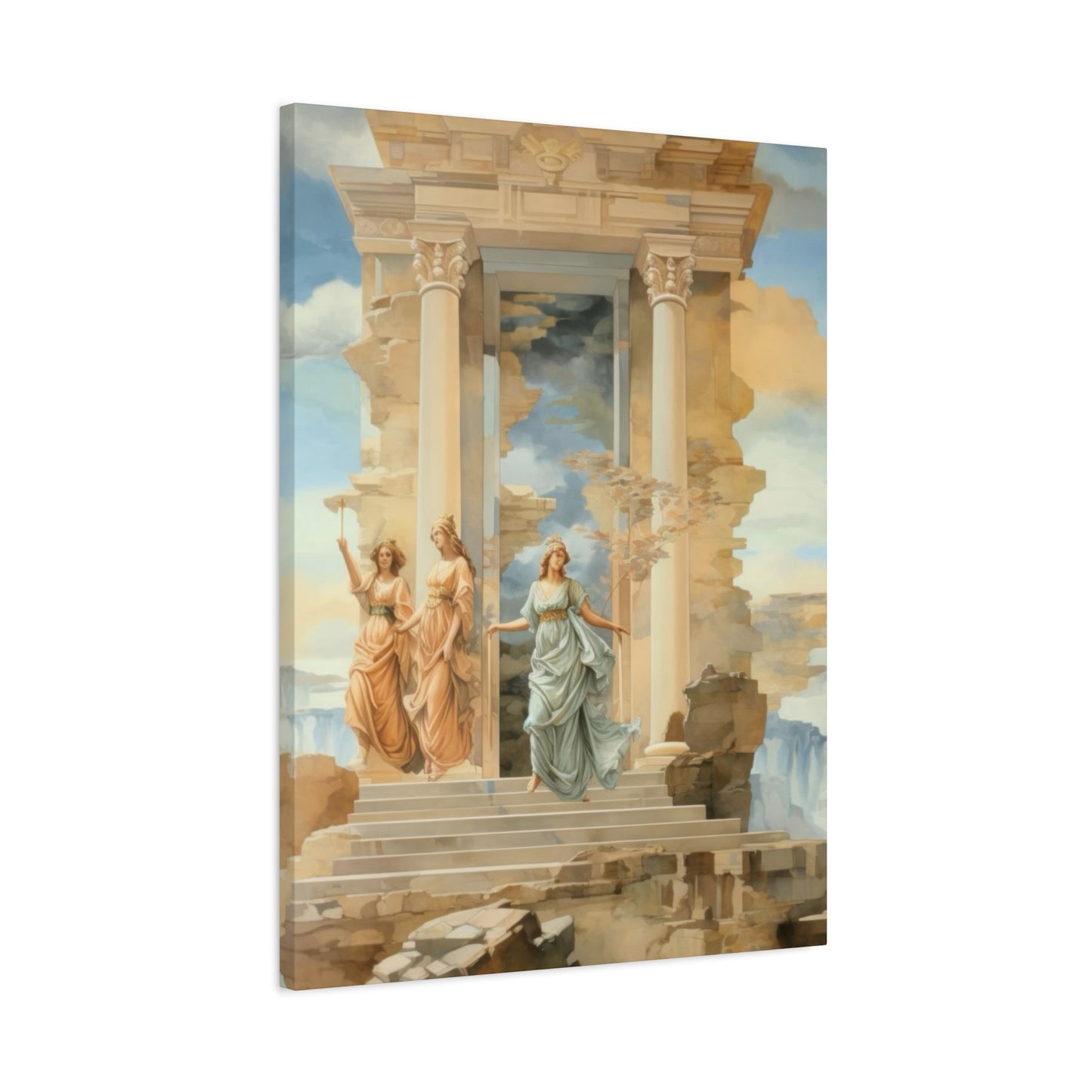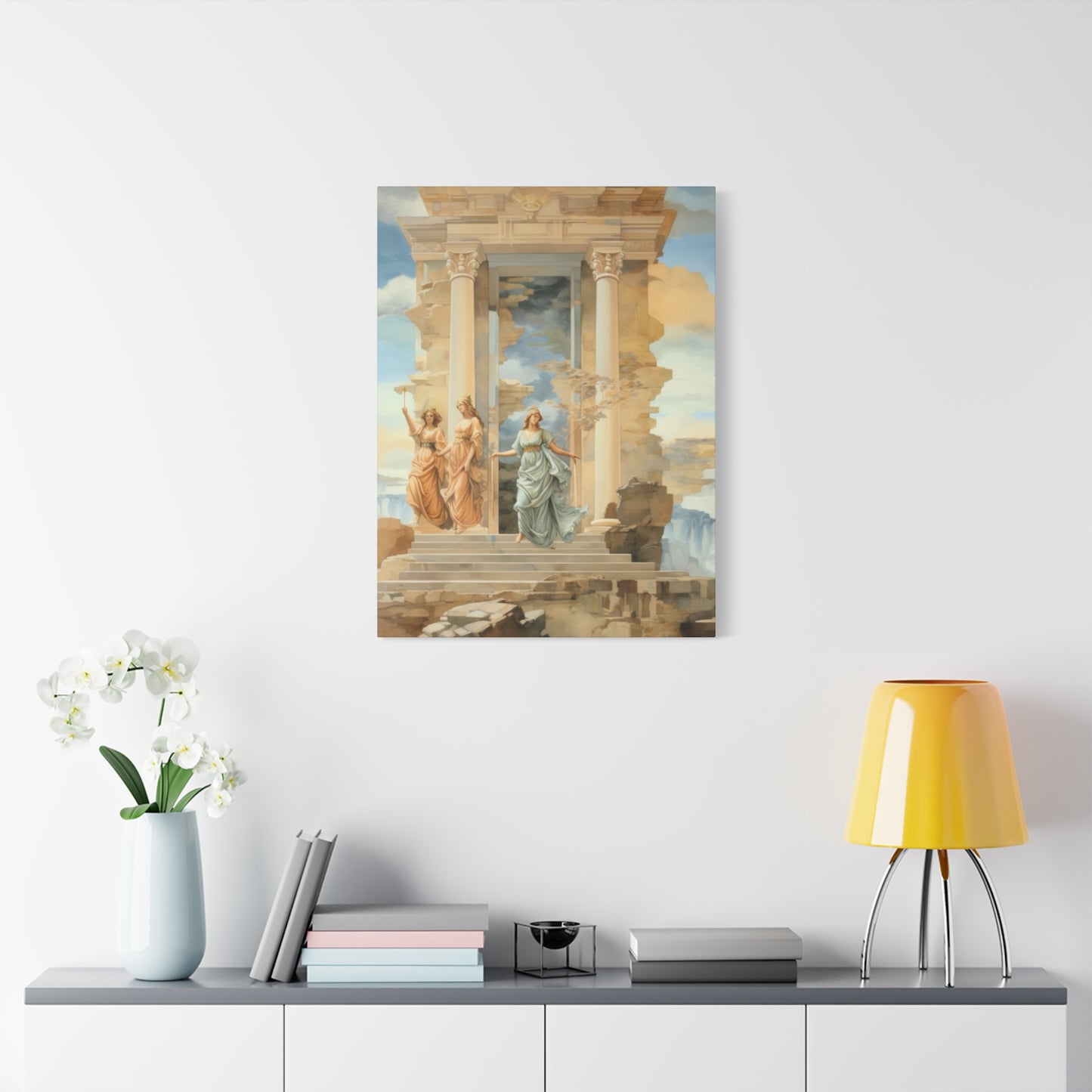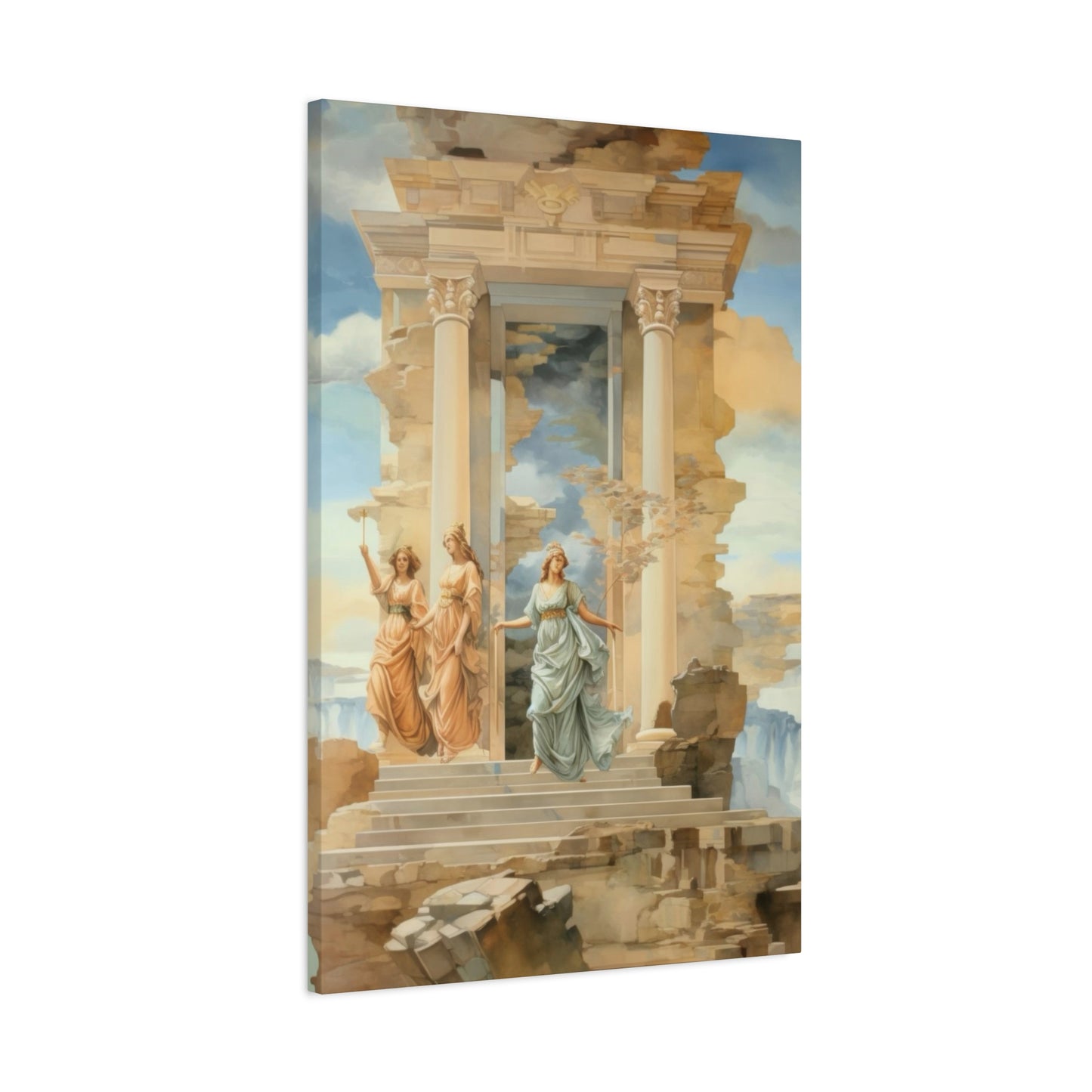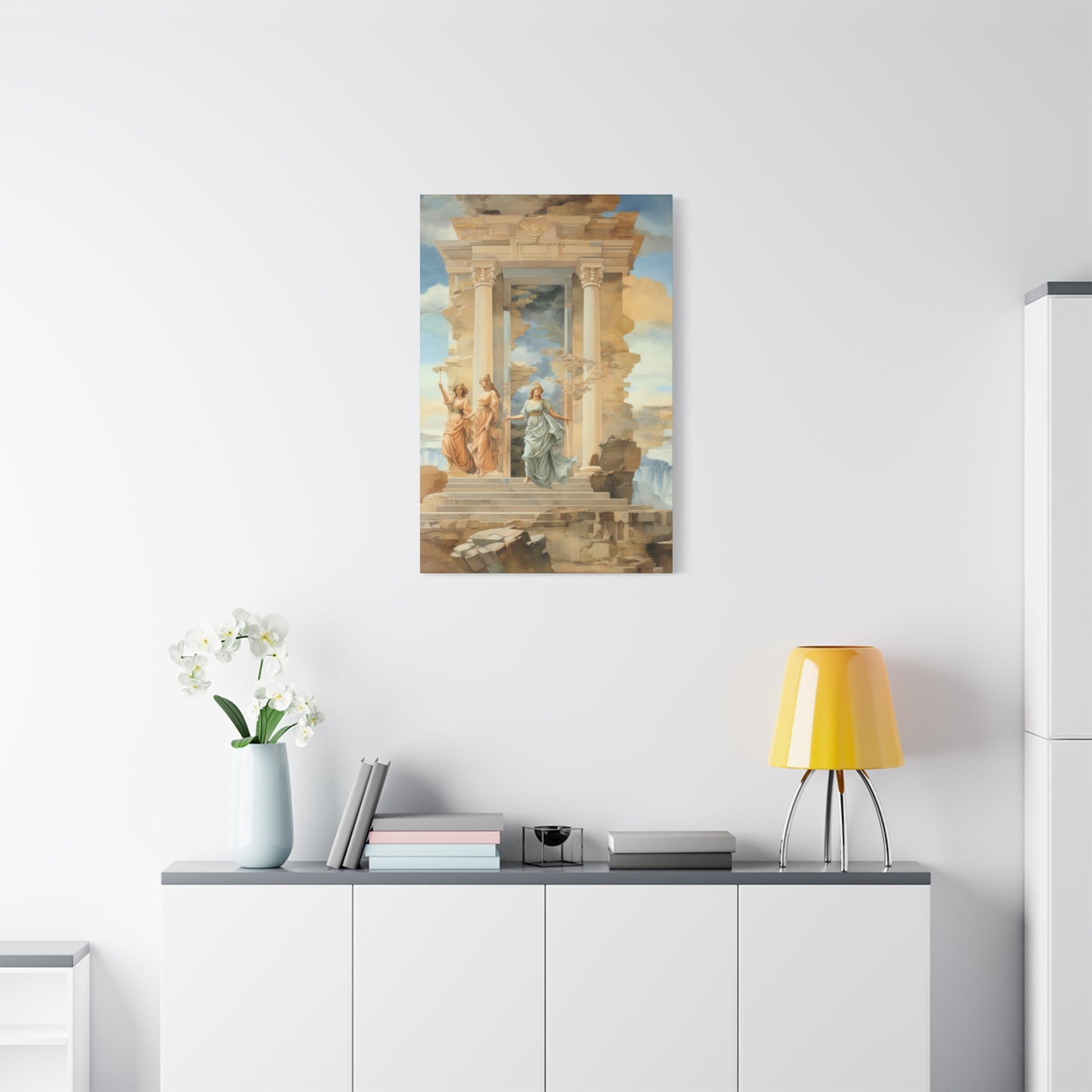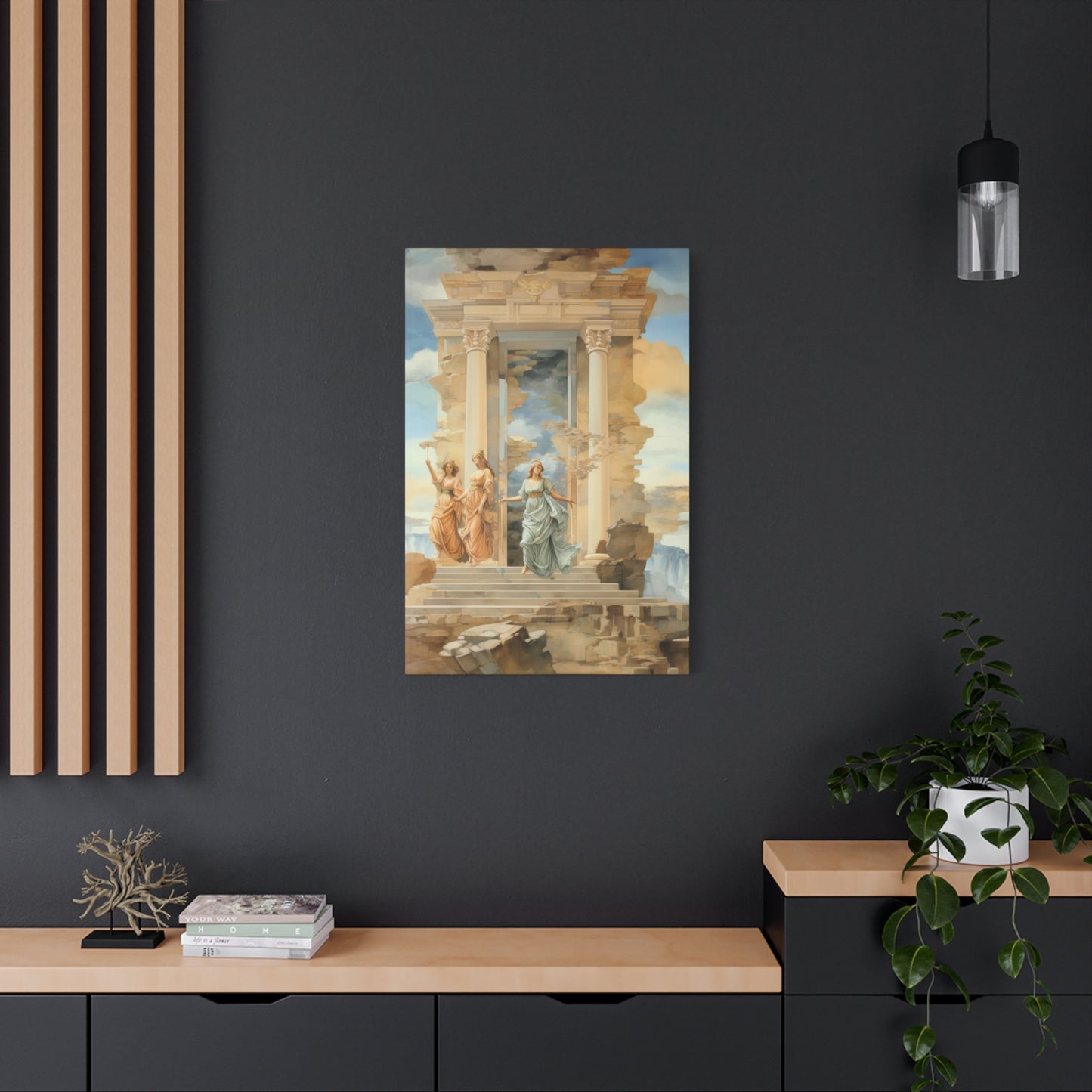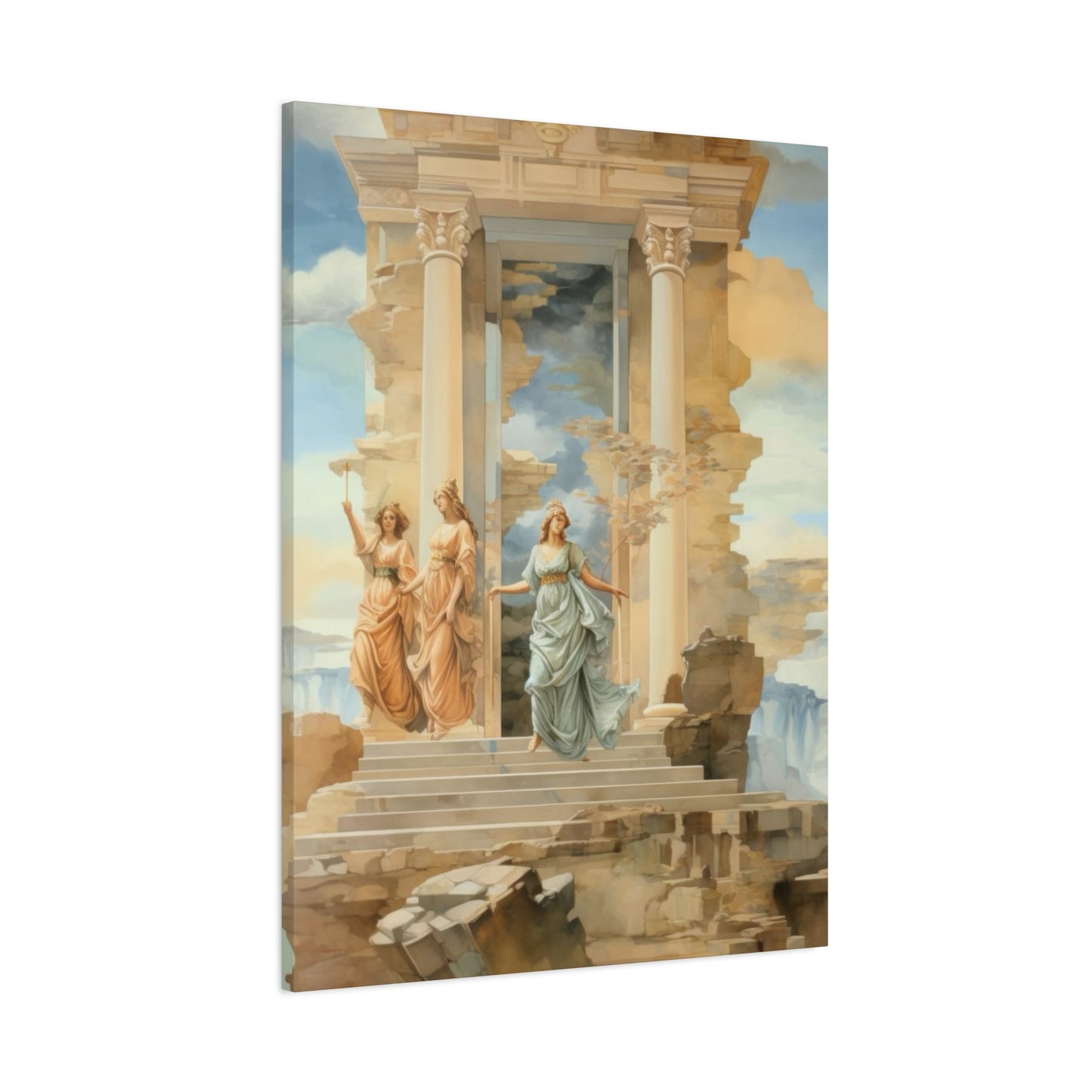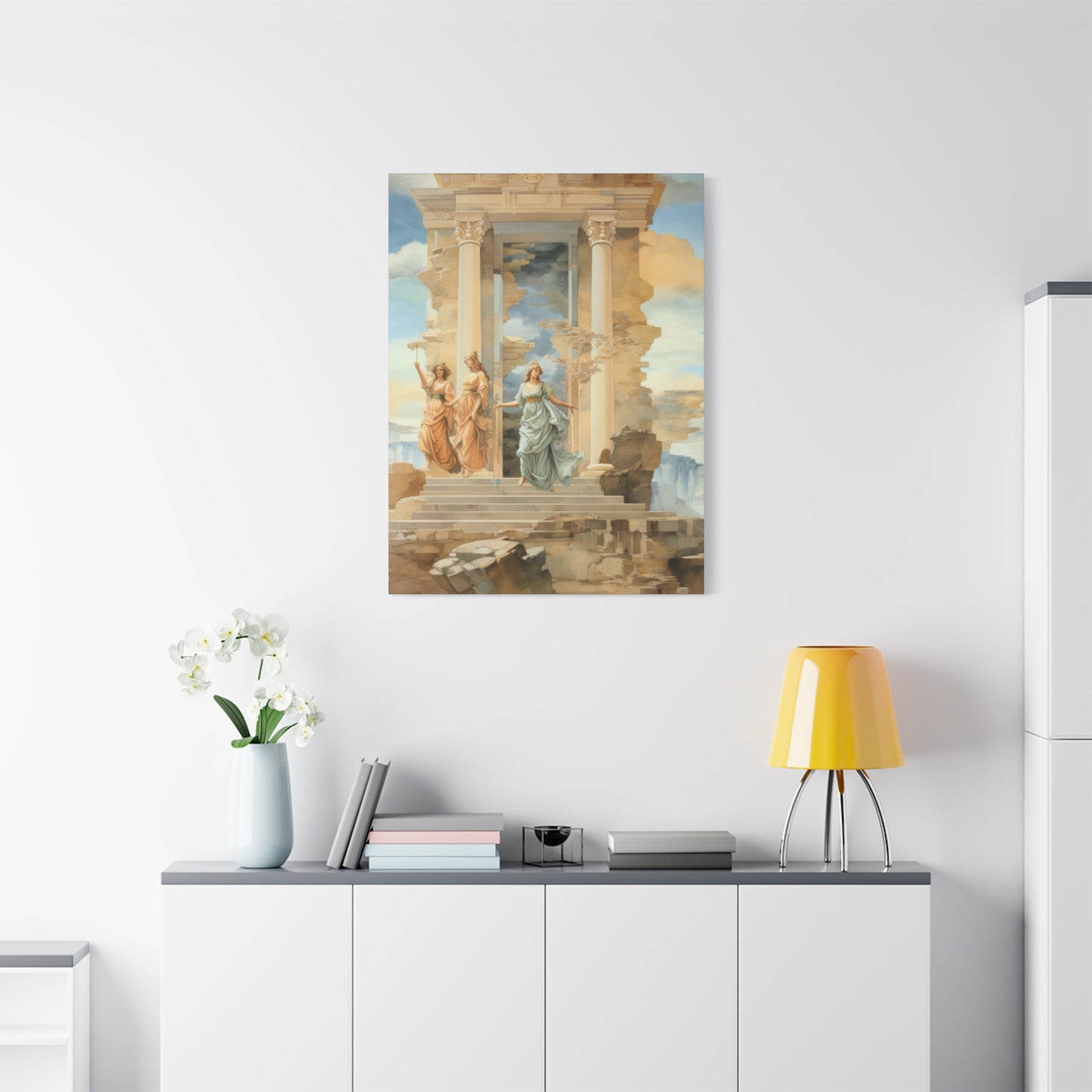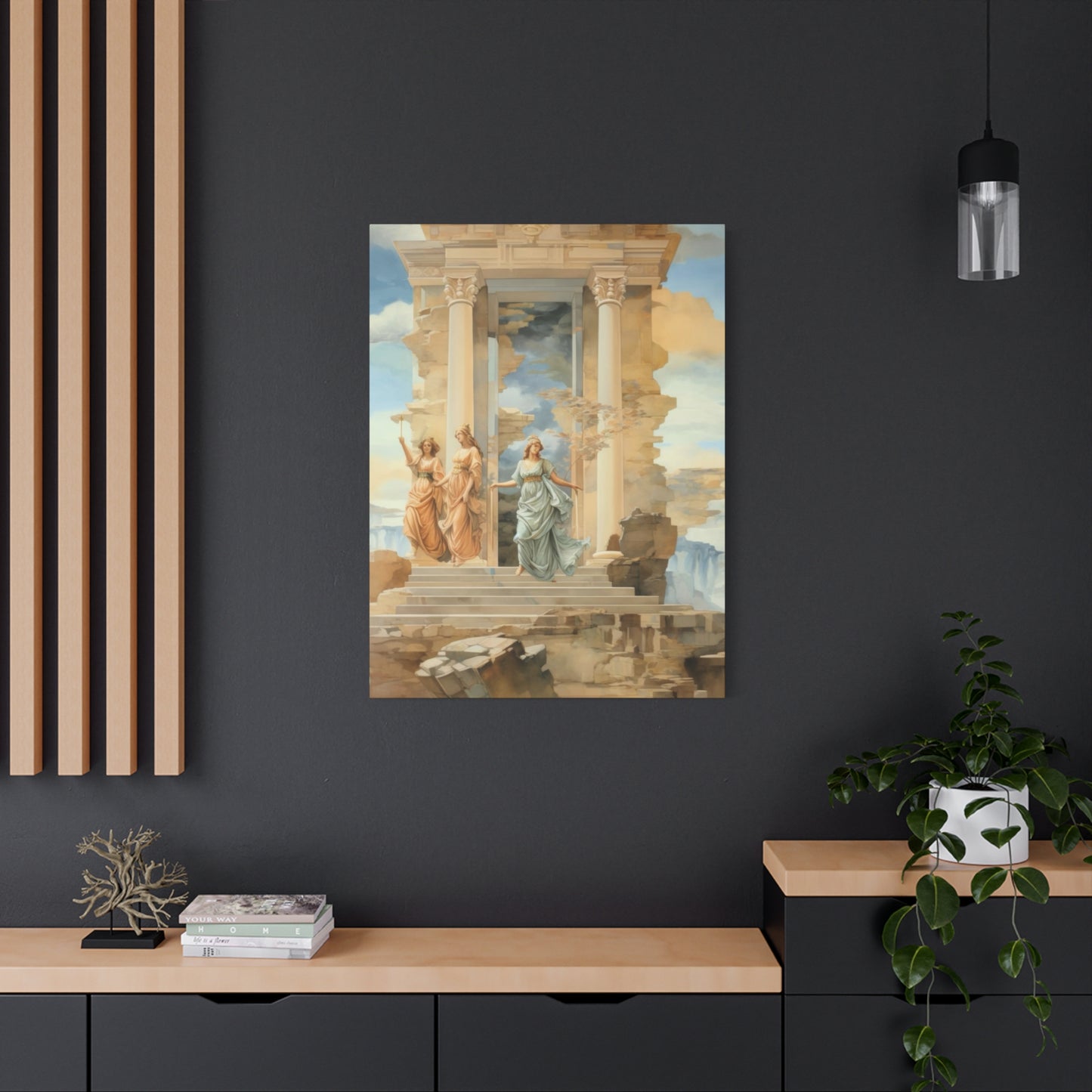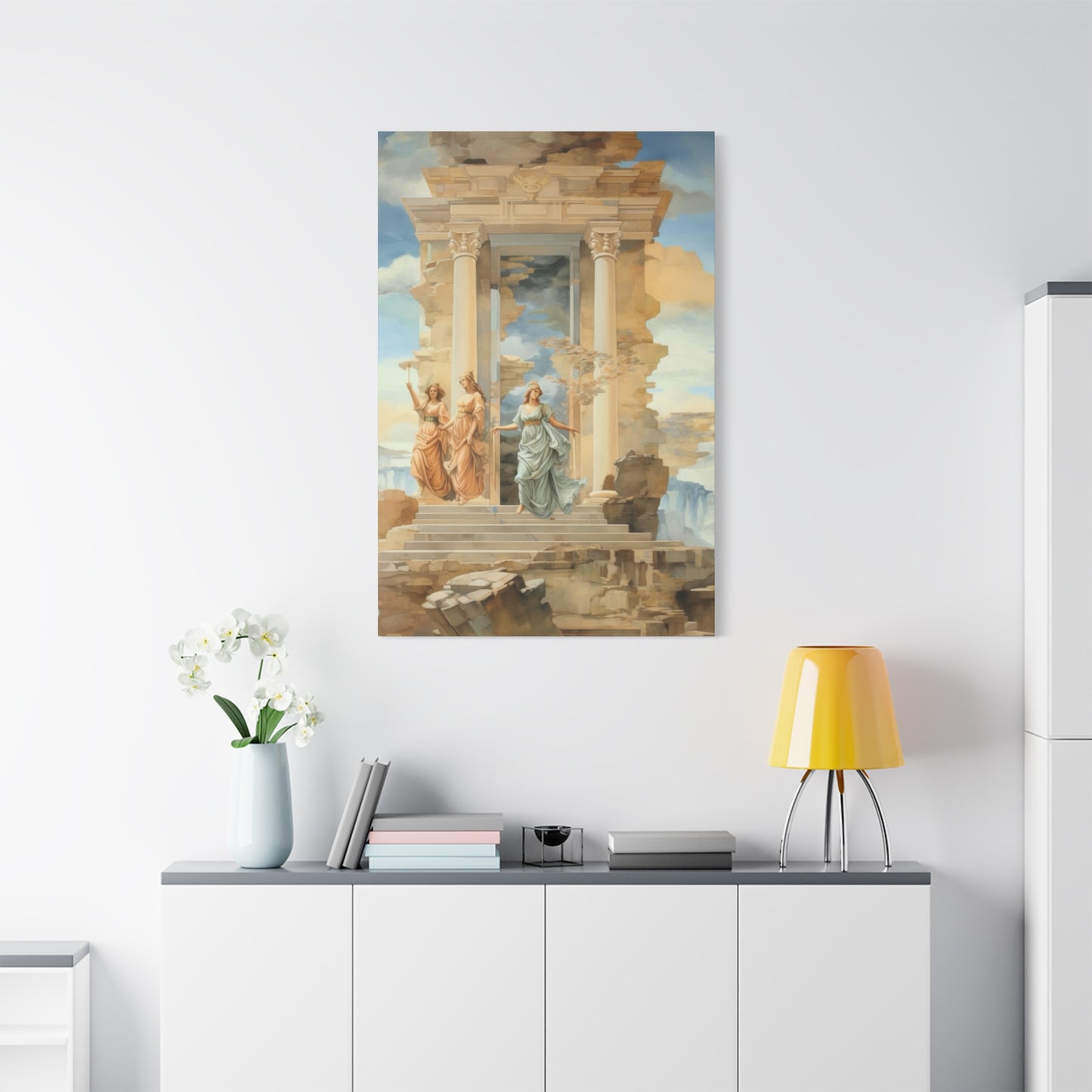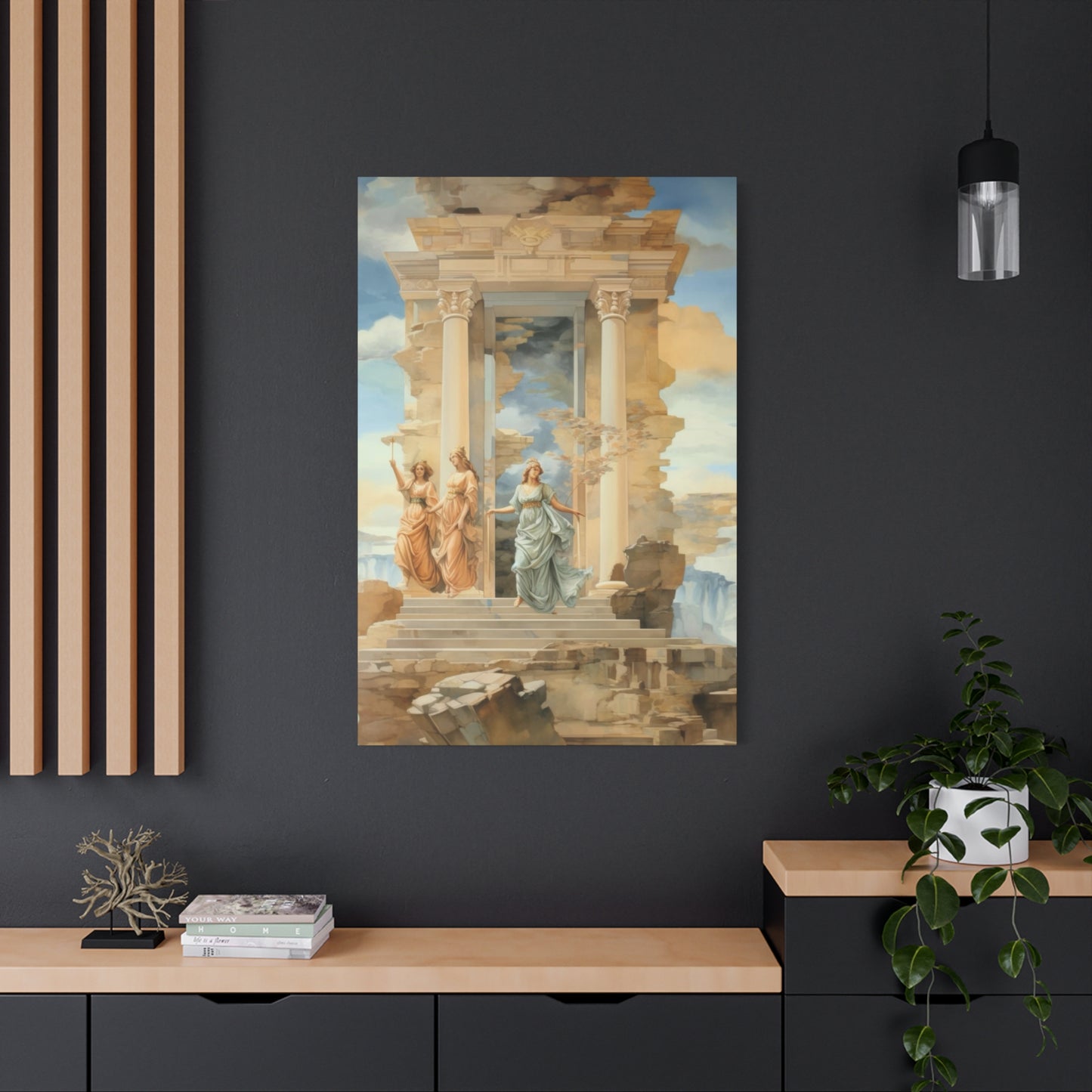Ancient Greece Earthy Opulence Wall Art: The Ultimate Guide to Timeless Elegance
The allure of ancient Greek aesthetics continues to captivate modern interior design enthusiasts, offering a bridge between historical grandeur and contemporary sophistication. When you bring ancient Greece earthy opulence wall art canvas prints into your living spaces, you're not merely adding decorative elements; you're inviting centuries of artistic heritage and cultural richness into your home. These stunning visual representations embody the philosophical depth, architectural mastery, and artistic excellence that defined one of history's most influential civilizations.
The concept of incorporating Hellenic-inspired artwork into modern interiors represents a harmonious blend of timeless beauty and current design trends. Each piece tells a story of gods and goddesses, heroic legends, architectural marvels, and the daily life of ancient citizens who shaped Western civilization. The earthy tones characteristic of these prints evoke the sun-baked landscapes of the Mediterranean, the warm terracotta of ancient pottery, and the golden hues of olive groves stretching across Greek hillsides.
Modern homeowners and interior designers increasingly recognize the transformative power of classical Greek-themed artwork. These pieces offer more than aesthetic appeal; they provide conversation starters, educational opportunities, and a sense of connection to human history's most celebrated artistic period. Whether you're drawn to depictions of the Parthenon's majestic columns, the graceful lines of Greek sculptures, or scenes from mythological tales, ancient Greece earthy opulence wall art canvas prints deliver an unmatched sophistication to any room.
The versatility of these artistic creations allows them to complement various interior design styles, from minimalist modern spaces to traditionally furnished rooms. The earthy color palettes featuring ochres, siennas, burnt oranges, deep terracottas, and warm beiges create a grounding effect that brings natural warmth to any environment. These hues reflect the authentic materials and pigments used in ancient Greek art, maintaining historical accuracy while satisfying contemporary aesthetic preferences.
Celebrating Greek Pottery and Ceramic Artistry in Wall Decor
Greek pottery represents one of the most distinctive and immediately recognizable art forms from antiquity, with its characteristic shapes, decorative techniques, and narrative scenes providing rich source material for ancient Greece earthy opulence wall art canvas prints. These ceramic masterpieces combined functional purpose with artistic excellence, creating objects that were simultaneously useful containers and decorated surfaces for storytelling.
Black-figure pottery, developed in the seventh century BCE, featured black silhouetted figures against the natural red-orange terracotta clay background. Artists incised fine details into the black slip before firing, revealing the lighter clay beneath to indicate features, clothing folds, and other details. This technique produced striking high-contrast images perfect for clear narrative storytelling. Modern canvas prints inspired by black-figure pottery capture this bold graphic quality, creating wall art with strong visual impact and immediate clarity.
Red-figure pottery, invented around 530 BCE, reversed the color scheme by painting the background black and leaving figures in the natural clay color. This allowed for more naturalistic details since artists could paint fine lines rather than incising them, resulting in more subtle and expressive representations. The red-figure technique enabled greater anatomical accuracy, more complex compositions, and more nuanced storytelling. Wall art based on red-figure pottery brings sophisticated classical imagery into contemporary spaces.
Pottery shapes varied according to function, with each form designed for specific purposes. Amphorae, tall storage jars with two handles, held wine, oil, or grain. Kraters, large mixing bowls, combined wine and water for drinking. Kylix, wide shallow drinking cups, featured circular interior spaces perfect for decorative scenes. Lekythos, slender oil flasks, often contained offerings for the dead. Hydria, water jars with three handles, were carried to and from fountains. Canvas prints incorporating these distinctive vessel shapes celebrate Greek form-follows-function design principles while adding sculptural interest to wall compositions.
Geometric pottery, from an earlier period of Greek art, featured abstract patterns—meanders, triangles, circles, and stylized figures—arranged in horizontal bands around vessels. This highly ordered, mathematical approach to decoration appeals to modern minimalist sensibilities. Wall art inspired by geometric pottery patterns brings structured beauty to contemporary interiors, proving that ancient design principles remain relevant.
Pottery decoration subjects ranged from mythological narratives to daily life scenes. Athletic competitions, symposium parties, women fetching water at fountains, warriors arming for battle, marriage processions, and funeral rites all appeared on pottery surfaces. These glimpses into ancient life provide fascinating windows into Greek culture and society. Canvas prints featuring such scenes serve dual purposes as decorative art and historical documentation, making them particularly appealing for educational homes or those with interest in ancient cultures.
The Panathenaic amphorae, special vessels awarded to victors in the Panathenaic Games, featured standardized decoration showing Athena on one side and the specific athletic event on the other. These prestigious prizes, filled with olive oil from Athena's sacred groves, represented athletic achievement and divine favor. Wall art featuring Panathenaic amphora designs celebrates athletic excellence and competitive spirit, making them appropriate for home gyms, game rooms, or sports enthusiasts' spaces.
White-ground pottery, less common but particularly refined, featured a white slip background that allowed for polychrome painting in additional colors beyond the standard black and red. These delicate pieces, often used for religious or funerary purposes, showcase Greek artists' abilities with multiple pigments. Canvas prints inspired by white-ground pottery offer softer, more varied color palettes while maintaining authentic Greek aesthetic principles.
Bringing Greek Sculptural Excellence into Your Home
Greek sculpture revolutionized three-dimensional art, establishing standards for anatomical accuracy, emotional expression, and aesthetic idealism that influenced Western art for centuries. Ancient Greece earthy opulence wall art canvas prints featuring famous Greek sculptures make these masterpieces accessible for home display, allowing appreciation of sculptural genius in two-dimensional format.
The Archaic period's distinctive kouros and kore figures—standing male and female statues—demonstrate early Greek sculptural development. Kouroi, with their rigid frontal poses and archaic smiles, show Egyptian influence while developing a uniquely Greek approach to the human figure. Korai, clothed female figures, showcase elaborate drapery and individualized features. These early sculptures, captured in canvas prints, trace the evolution toward greater naturalism while maintaining formal dignity and spiritual presence.
Classical period sculpture achieved unprecedented naturalism and idealized beauty. The Kritios Boy, showing the first contrapposto stance with weight shifted to one leg, revolutionized how sculptors depicted the human body at rest. The Riace Warriors, magnificent bronze figures recovered from the sea, demonstrate mastery of muscular anatomy and dynamic presence. The Discobolus (Discus Thrower), frozen mid-motion, captures athletic action with unprecedented realism. Wall art featuring these classical masterpieces brings the period's aesthetic perfection into modern spaces.
The Parthenon sculptures, including pediments, metopes, and frieze, represent collaborative sculptural projects of extraordinary quality. The Panathenaic Procession frieze, showing hundreds of figures in a continuous narrative, demonstrates sophisticated composition and varied characterization. The metopes depicting centauromachy and other mythological battles showcase dynamic action in confined square spaces. The pediment sculptures, representing the birth of Athena and the contest between Athena and Poseidon, created fully realized three-dimensional compositions designed for specific architectural settings. Canvas prints of these sculptures connect viewers with one of art history's greatest sculptural programs.
Female sculpture evolved from the modest drapery of early periods to the highly developed wet drapery technique showing body forms through seemingly transparent fabric. The Nike of Samothrace, her wings spread and drapery pressed against her body by wind, demonstrates both technical mastery and dramatic composition. The various Venus statues—Venus de Milo, Venus of Knidos—represent idealized feminine beauty. Wall art featuring these female figures adds grace and elegance to any space, celebrating Greek achievements in representing the female form.
Hellenistic sculpture emphasized emotional expression, dynamic movement, and dramatic subjects. The Laocoön Group, showing the Trojan priest and his sons struggling against serpents, displays anguish and physical strain. The Dying Gaul captures pathos in a defeated warrior. The Old Market Woman shows Greek sculptors' willingness to depict age and hardship rather than only youth and beauty. These emotionally powerful subjects, translated into canvas prints, create dramatic focal points that engage viewers emotionally.
Portrait sculpture, particularly from the Hellenistic period, achieved remarkable individualization. Portraits of Alexander the Great, showing the young conqueror with upturned gaze and wild hair, established iconography for depicting rulers. Philosopher portraits captured individual features while conveying intellectual character. These personalized sculptures, featured in wall art, bring historical figures into contemporary spaces while demonstrating Greek innovation in realistic portraiture.
Chryselephantine statues, monumental figures constructed of gold and ivory over wooden cores, represented the height of sculptural luxury. The Athena Parthenos and Zeus at Olympia, both created by Phidias, were ancient world wonders that no longer survive. Reconstructions and descriptions allow artists to imagine these spectacular works. Canvas prints depicting these lost masterpieces connect viewers with Greek sculptural ambition and religious devotion while adding opulent golden tones to earthy color palettes.
Designing Gallery Walls with Classical Greek Themes
Gallery walls allow creative arrangement of multiple ancient Greece earthy opulence wall art canvas prints to create cohesive, visually interesting displays that make maximum impact. This approach offers flexibility for incorporating various subjects, sizes, and styles while maintaining thematic unity through shared Greek inspiration and complementary color palettes.
Planning gallery wall layouts requires consideration of wall dimensions, furniture placement, and desired visual effect. Symmetrical arrangements create formal, balanced appearances appropriate for traditional spaces. A central large piece flanked by smaller works in mirror arrangement provides classical orderliness. Alternatively, asymmetrical layouts offer dynamic, contemporary feels where pieces of varying sizes create organic compositions. Grid arrangements, with uniformly sized and spaced prints, deliver modern minimalist aesthetics while showcasing multiple Greek subjects.
Thematic coherence unifies disparate pieces within gallery walls. Consider grouping prints around specific themes—all mythological subjects, all architectural imagery, all pottery-inspired designs, or all sculptural reproductions. Alternatively, create thematic variety within carefully controlled parameters, perhaps showing different aspects of Greek culture (architecture, pottery, sculpture, mythology) while maintaining consistent earthy color palettes and framing styles.
Color coordination ensures visual harmony across multiple prints. Ancient Greece earthy opulence wall art canvas prints naturally share warm, earthy tones, but consider the specific balance of terracottas, ochres, blacks, and neutrals across your selected pieces. Too many similarly colored prints may appear monotonous, while too much color variation creates chaos. Aim for a balanced distribution where colors appear multiple times across the arrangement, creating visual connections and rhythm.
Size progression adds interest to gallery walls. Include one or two larger statement pieces that anchor the arrangement, medium-sized works that provide substance, and smaller accent pieces that fill spaces and add detail. The largest pieces need not occupy the center—placing a major work off-center creates dynamic asymmetry while smaller surrounding pieces balance the composition.
Frame consistency versus variety represents a key decision. Matching frames across all prints creates refined, cohesive appearances appropriate for formal spaces. Slight variations in frame width or finish while maintaining a single color family allows subtle diversity. Deliberately varied frames—mixing modern and traditional styles, different colors, or diverse materials—creates eclectic, collected-over-time aesthetics. When varying frames, ensure some unifying element, perhaps mat board color or print orientation, maintains coherence.
Spacing between prints affects overall impact. Closer spacing creates unified fields where individual pieces merge into collective displays. Wider spacing emphasizes each print's independence while creating breathing room. Standard spacing of two to four inches between frames works well for most gallery walls, though this can be adjusted based on print sizes and wall dimensions.
Balancing subject matter creates visual interest while avoiding redundancy. If including multiple mythological scenes, vary the specific stories and compositional approaches. Mix close-up architectural details with wider views of complete structures. Combine pottery-inspired patterns with figural scenes. Alternate between calm, contemplative subjects and dynamic, action-filled imagery.
Enhancing Different Room Atmospheres with Greek Wall Art
Different living spaces benefit from thoughtfully selected ancient Greece earthy opulence wall art canvas prints that enhance each room's specific function and desired atmosphere. Understanding how Greek-themed artwork interacts with room purpose allows strategic selection that maximizes both aesthetic appeal and functional appropriateness.
Living rooms, serving as primary gathering and entertaining spaces, accommodate impressive statement pieces that spark conversation and showcase homeowner taste. Large-scale prints featuring panoramic temple views, dramatic mythological scenes, or groupings of Greek sculptures create focal points that anchor room design. The warm earthy tones characteristic of Greek-inspired art enhance living room coziness while sophisticated classical subjects demonstrate cultural refinement. Consider placing major pieces above sofas, over fireplaces, or on prominent walls where guests naturally focus attention.
Dining rooms benefit from Greek artwork related to hospitality, abundance, and communal gathering. Symposium scenes showing ancient banquets, harvest imagery featuring grapevines and wheat, pottery decorated with wine vessels, or depictions of Dionysus (god of wine) and Demeter (goddess of harvest) thematically connect to dining room functions. The warm, appetite-enhancing qualities of terracotta and ochre tones complement dining experiences while creating intimate, convivial atmospheres. Position artwork at eye level for seated diners, ensuring comfortable viewing during meals.
Bedrooms call for more serene, contemplative subjects that promote relaxation and rest. Peaceful landscape scenes featuring Greek islands, graceful sculptural figures in repose, abstract geometric patterns inspired by Greek design, or gentle mythological subjects like sleeping Ariadne create calming environments. Avoid overly dramatic or action-packed scenes that might prove visually stimulating when trying to unwind. The earthy color palette naturally promotes restfulness, with warm tones creating cocoon-like comfort without excessive visual excitement.
Home offices benefit from Greek imagery that inspires focus, wisdom, and intellectual achievement. Depictions of Athena (goddess of wisdom), portraits of famous Greek philosophers, architectural details showing mathematical precision, or scenes from the Academy or Library of Alexandria create environments conducive to mental work. These subjects provide visual interest during work breaks while reinforcing values of learning, strategic thinking, and intellectual excellence. Position artwork where visible during periodic glances away from computer screens, providing opportunities for visual rest while maintaining inspirational presence.
Bathrooms, spaces dedicated to personal care and relaxation, connect naturally with Greek bathing culture and water-related imagery. Depictions of Poseidon and sea creatures, scenes of ancient baths, decorative pottery patterns, or oceanic landscape views enhance bathroom themes. The moisture-resistant qualities of canvas prints make them suitable for bathroom environments, though ensure adequate ventilation to protect artwork. Smaller prints work well in typically compact bathroom spaces, with vertical orientations accommodating narrow wall sections.
Entryways and hallways benefit from Greek artwork that makes strong first impressions while accommodating traffic flow. Impressive architectural scenes, particularly gateway structures like propylaea, thematically suit entry spaces. Gallery wall arrangements work excellently in hallways, transforming transitional spaces into art corridors. Ensure adequate lighting in these often-darker spaces to showcase artwork effectively. Consider sight lines—artwork visible from adjacent rooms should coordinate with those spaces' overall aesthetics.
Children's rooms and playrooms offer opportunities for educational Greek-themed artwork featuring mythological stories, heroes, and creatures that spark imagination. The narrative richness of Greek myths provides endless entertainment while introducing classical culture. Consider including explanatory text with prints, turning wall art into teaching tools. The warm, non-threatening quality of earthy color palettes suits children's spaces better than harsh, primary colors, creating sophisticated yet age-appropriate environments.
Libraries and reading nooks naturally pair with Greek intellectual and literary themes. Depictions of the Muses, ancient libraries, manuscript scrolls, or writers and poets create atmospheres celebrating learning and literature. Position artwork where visible from comfortable reading chairs, providing contemplative focal points during reading breaks. The scholarly associations of Greek culture enhance library environments while the warm color palette promotes the cozy comfort essential for pleasant reading spaces.
Creating Harmonious Color Schemes Around Greek Wall Art
Successfully integrating ancient Greece earthy opulence wall art canvas prints into existing interiors requires thoughtful color coordination that honors the artwork while creating cohesive room designs. The warm, earthy palette characteristic of Greek-inspired art provides an excellent foundation for developing sophisticated, harmonious color schemes throughout your space.
Monochromatic approaches utilize various shades, tints, and tones of single colors drawn from your canvas prints. Select a dominant hue from the artwork—perhaps terracotta, ochre, or olive—and build room color around lighter and darker variations. Terracotta artwork might inspire pale peachy walls, rust-colored accent pillows, and deep burnt sienna throw blankets. This approach creates refined, cohesive environments where artwork integrates seamlessly rather than contrasting sharply with surroundings.
Analogous color schemes combine colors adjacent on the color wheel, creating harmonious combinations with subtle variety. The earthy palette naturally includes oranges, reds, and yellows—all neighboring hues. Combine terracotta artwork with golden ochre textiles, rust accessories, and warm cream backgrounds. Add olive green as a cooling adjacent color that provides relief from warm tones while maintaining harmony. These combinations feel natural and balanced, reflecting color relationships found in Mediterranean landscapes.
Complementary approaches pair colors opposite on the color wheel for dynamic contrast. The warm oranges and reds characteristic of Greek-inspired art complement cool blues and blue-greens. Consider pairing terracotta canvas prints with slate blue walls, navy accent furniture, or turquoise decorative objects. This combination references the relationship between Greek terracotta pottery and the blue Aegean Sea, creating vibrant yet historically authentic color stories.
Neutral foundations allow ancient Greece earthy opulence wall art canvas prints to command attention without color competition. White, cream, beige, gray, and taupe walls, furniture, and major surfaces create blank canvases that make artwork pop. The warm earthy tones in Greek-inspired prints provide all necessary color, preventing neutral rooms from appearing cold or sterile. This approach suits minimalist and contemporary interiors where artwork serves as the primary decorative element.
Earthy layering builds upon the canvas prints' existing palette by incorporating additional natural materials and colors. Combine terracotta artwork with leather furniture in cognac or tobacco shades, natural wood surfaces, woven textiles in wheat and flax tones, and stone or ceramic accessories. Layer various earth tones—from pale sand to deep umber—creating rich, textured environments that feel grounded and organic. This approach amplifies the natural, earthy qualities inherent in Greek-inspired art.
Metallic accents add luxury and sophistication to Greek-themed color schemes. Gold, bronze, and copper accessories reference ancient Greek metalwork and add warm, reflective surfaces that complement earthy tones. Brushed gold frames, bronze sculptural objects, copper vessels, or gold-finished lighting fixtures enhance the opulence suggested in ancient Greece earthy opulence wall art canvas prints. These metallic touches elevate earthy foundations from casual to refined.
Black and white contrast provides graphic punch while maintaining elegance. The black-figure pottery technique utilized bold black against terracotta backgrounds, creating high-contrast compositions. Modern interiors can reference this by combining canvas prints with black furniture, white walls, and black and white patterned textiles. This approach creates sophisticated, gallery-like environments where Greek artwork receives prominence against neutral backdrops.
Accent colors introduce controlled pops that enliven earthy foundations without overwhelming them. Deep wine reds, purple-blues, forest greens, or rich burgundy can appear in small doses through pillows, vases, books, or flowers. These jewel tones provide visual excitement while earthy canvas art maintains overall color direction. Keep accent colors to approximately ten percent of the room's total color distribution, ensuring they enhance rather than dominate.
Illuminating Your Canvas Art with Strategic Lighting Design
Proper lighting transforms ancient Greece earthy opulence wall art canvas prints from simple wall decorations into glowing focal points that command attention and showcase artistic details. Strategic lighting design considers both artwork protection and optimal visual presentation, ensuring your Greek-inspired pieces appear their best while avoiding damage.
Picture lights mounted directly above or below canvas frames provide dedicated illumination specifically for artwork. These fixtures direct light precisely where needed, highlighting details and colors while creating subtle dramatic effects. LED picture lights offer energy efficiency and low heat emission, protecting canvas from heat damage. Adjustable picture lights allow custom positioning to minimize glare and shadows. The warm tones in Greek-inspired art benefit from warm-white (2700-3000K) LED bulbs that enhance terracotta and ochre hues rather than cool-white lights that can make warm colors appear dull.
Track lighting offers flexible illumination suitable for gallery wall arrangements or rooms with multiple art pieces. Adjustable track heads direct light exactly where desired, accommodating artwork of various sizes and positions. This approach works excellently when displaying multiple ancient Greece earthy opulence wall art canvas prints throughout a space, allowing customized lighting for each piece. Position track heads at 30-degree angles from artwork to minimize glare while providing adequate illumination.
Recessed ceiling spotlights provide architectural lighting solutions that integrate seamlessly with room design. Position spotlights approximately two to three feet from walls, angling light toward artwork to create even illumination without harsh shadows or glare. Multiple spotlights can illuminate large canvas prints or gallery arrangements, ensuring consistent lighting across entire displays. Dimmer switches allow adjustable intensity, accommodating different times of day and desired atmospheres.
Wall washers create broad, even illumination across entire wall surfaces, bathing artwork in gentle, non-directional light. This approach suits contemporary spaces where integrated lighting trumps obvious fixtures. Wall washing particularly benefits gallery wall arrangements where multiple prints require simultaneous illumination. The even distribution prevents individual pieces from receiving unequal lighting that might favor some artworks over others.
Natural light provides beautiful illumination but requires careful management to prevent artwork damage. Never position canvas prints where direct sunlight falls, as UV radiation causes irreversible fading and degradation. Place Greek-inspired artwork on walls perpendicular to windows rather than opposite them, allowing natural light to graze across canvas surfaces without direct exposure. Sheer curtains, UV-filtering window films, or adjustable blinds provide additional protection while permitting natural illumination.
Accent lighting creates atmospheric effects that enhance overall room ambiance while showcasing artwork. Table lamps, floor lamps, and wall sconces positioned near canvas prints contribute indirect illumination that brings attention to artwork without harsh spotlighting. This layered lighting approach creates depth and visual interest while maintaining comfortable, livable environments. The warm glow from traditional incandescent-style bulbs particularly complements the earthy tones in Greek-inspired art.
Light temperature significantly affects how colors appear. Warm white light (2700-3000K) enhances reds, oranges, and yellows—the dominant colors in ancient Greece earthy opulence wall art canvas prints. Neutral white (3500-4000K) provides balanced illumination suitable for spaces with varied color palettes. Cool white (5000-6500K) enhances blues and can make warm colors appear dull. Select light temperature that complements your artwork's specific color balance, generally favoring warm white for Greek-inspired pieces.
Lighting intensity should illuminate artwork adequately without excessive brightness that causes eye strain or accelerates fading. Aim for illumination levels approximately three times brighter than general room lighting, ensuring artwork stands out while maintaining comfortable viewing. Light meters or smartphone apps can measure illumination levels, helping achieve optimal brightness. Dimmer controls allow adjusting intensity for different times and purposes.
Preserving and Maintaining Your Canvas Print Collection
Proper care ensures ancient Greece earthy opulence wall art canvas prints remain beautiful for years, maintaining color vibrancy and structural integrity. Understanding preservation principles and implementing appropriate maintenance routines protect your investment while allowing continued enjoyment of Greek-inspired artwork.
Display location dramatically affects canvas longevity. Avoid walls where direct sunlight falls, as ultraviolet radiation causes irreversible color fading and canvas degradation. Even indirect bright light accelerates aging, so consider light exposure when selecting display locations. Avoid hanging canvas prints directly above heat sources like radiators, fireplaces, or heating vents, as excessive heat dries canvas, making it brittle and prone to cracking. Similarly, avoid extremely humid environments like steamy bathrooms without adequate ventilation, as excess moisture promotes mold growth and canvas deterioration.
Temperature and humidity stability prevents physical stress on canvas materials. Fluctuating conditions cause expansion and contraction that loosens canvas tension and may crack printed surfaces. Maintain consistent room temperatures between 65-75 degrees Fahrenheit and relative humidity between 40-55 percent. Use humidifiers in dry climates or dehumidifiers in humid environments to maintain optimal conditions. These precautions particularly matter for valuable or irreplaceable pieces.
Regular dusting prevents accumulation that dulls appearance and potentially damages surfaces. Use soft, clean microfiber cloths or feather dusters to gently remove surface dust. Never use rough materials or apply pressure that might scratch or damage printed surfaces. Dust from top to bottom, allowing particles to fall away from canvas. Perform this gentle cleaning monthly or as needed based on household dust levels.
Avoid chemical cleaners, water, or liquid solutions on canvas surfaces, as these can damage printing, cause colors to run, or promote mold growth. If cleaning beyond dusting becomes necessary, consult professional art conservators rather than attempting potentially damaging home treatments. The protective coatings applied during production provide most canvas prints with adequate protection against minor soiling.
Protective glazing, though uncommon for canvas prints, offers additional protection for particularly valuable pieces. Acrylic or glass covers prevent physical contact, dust accumulation, and provide UV filtering. However, glazing increases cost, weight, and complication while potentially creating glare. Most canvas prints display beautifully without glazing, but consider this option for heirloom-quality pieces or particularly vulnerable locations.
Periodic inspection identifies developing problems before they become serious. Every few months, examine canvas prints for signs of fading, loosening canvas, frame damage, or other issues. Check that canvas remains taut without sagging. Ensure frames remain secure and hanging hardware functions properly. Early detection allows timely intervention that prevents minor issues from escalating into major problems.
Professional restoration addresses significant damage or aging. If canvas prints develop tears, substantial fading, mold growth, or structural problems, consult professional art conservators. Attempting amateur repairs may cause additional damage. Professionals possess specialized knowledge and materials for safely treating canvas artwork, potentially salvaging pieces that might otherwise be lost.
Rotation prevents uneven fading and allows enjoying different pieces seasonally. If you maintain multiple ancient Greece earthy opulence wall art canvas prints, periodically rotate displayed pieces, giving some rest in dark storage while showcasing others. This practice particularly benefits collections displayed in challenging lighting conditions, distributing exposure across multiple pieces rather than concentrating wear on constantly displayed favorites.
Exploring Different Artistic Styles in Greek-Inspired Wall Art
Ancient Greece earthy opulence wall art canvas prints encompass diverse artistic interpretations ranging from photorealistic representations to abstract modern interpretations. Understanding these stylistic variations helps select artwork that matches your aesthetic preferences and interior design approach.
Photorealistic representations reproduce Greek sculptures, pottery, architecture, and artifacts with camera-like accuracy. These detailed, precise renderings showcase Greek art's finest details, allowing close examination of sculptural surfaces, pottery decoration, and architectural elements. Photorealistic prints suit traditional interiors, educational settings, and spaces where historical accuracy matters. The hyperrealistic approach celebrates Greek artistic achievements while providing reference-quality imagery that faithfully documents original works.
Classical painting interpretations apply traditional oil painting techniques to Greek subjects, creating artwork that appears hand-painted rather than photographed or digitally produced. Visible brushstrokes, painterly texture, and artistic interpretation add warmth and humanity to Greek themes. This approach references the European academic tradition of classical painting that drew heavily on Greek subjects. Classical painting style suits formal, traditional interiors where artistic interpretation is valued over documentary precision.
Watercolor-inspired styles create softer, more romantic interpretations of Greek subjects with translucent colors, fluid edges, and atmospheric qualities. Watercolor treatments particularly suit landscape scenes featuring Greek islands, coastal views, and distant temple ruins, where dreamy, impressionistic qualities enhance romantic appeal. The lighter touch of watercolor style balances the earthiness of Greek-inspired color palettes, preventing them from appearing too heavy or dark.
Abstract interpretations distill Greek motifs to essential shapes, patterns, and colors, creating contemporary artwork that references Greek culture without literal representation. Geometric patterns inspired by Greek pottery, simplified architectural forms, color fields suggesting Mediterranean landscapes, or deconstructed mythological narratives provide modern takes on classical themes. Abstract Greek-inspired art suits contemporary and minimalist interiors where suggestion trumps explicit representation.
Graphic design approaches utilize bold shapes, limited color palettes, and strong compositions to create impactful modern statements. Silhouetted figures reminiscent of black-figure pottery, geometric patterns, minimalist column designs, or stylized mythological symbols create artwork that bridges historical reference and contemporary design. This approach appeals to modern sensibilities while maintaining clear connections to Greek inspiration.
Mixed media styles combine multiple artistic techniques—perhaps photography blended with painted elements, collaged materials, or digital manipulation. These contemporary approaches create unique interpretations that honor Greek traditions while embracing modern artistic freedom. Mixed media pieces work well in eclectic interiors that combine old and new elements, reflecting the fusion of ancient inspiration and contemporary creation.
Vintage poster styles reference early twentieth-century travel posters promoting Greek tourism. These nostalgic interpretations feature simplified forms, limited color palettes, and retro typography celebrating Greek destinations. Vintage-style Greek prints add nostalgic charm to spaces while maintaining thematic connection to Greek culture. This approach particularly suits casual, comfortable interiors with retro or vintage aesthetic elements.
Contemporary digital art creates Greek-inspired imagery using modern technology, from digital painting to 3D rendering to computational design. These cutting-edge approaches produce artwork impossible to create through traditional means while maintaining Greek thematic content. Digital art styles suit modern, tech-forward spaces where contemporary artistic innovation is celebrated.
Incorporating Greek Philosophical and Literary Themes
Ancient Greek contributions to philosophy and literature provide intellectually rich subjects for ancient Greece earthy opulence wall art canvas prints that add meaningful depth to decorative purposes. These cerebral themes suit studies, libraries, and spaces dedicated to contemplation and learning.
Famous philosophers offer compelling portrait subjects. Socrates, often depicted as an older man with distinctive features, represents the examined life and the Socratic method of questioning. Plato, shown as a more idealized figure, embodies abstract philosophical thought and the theory of forms. Aristotle, sometimes depicted with scientific instruments, represents empirical observation and systematic thinking. These philosophical portraits add intellectual gravitas to home offices and studies while celebrating human wisdom and rational inquiry.
Allegorical representations of philosophical concepts create symbolic artwork with multiple layers of meaning. The cave allegory from Plato's Republic, showing prisoners seeing only shadows, illustrates the difference between appearance and reality. The ship of Theseus raises questions about identity and change. The divided line depicts levels of knowledge and reality. These philosophical concepts translated into visual form create thought-provoking artwork that invites contemplation and discussion.
The Academy and Lyceum, famous schools of philosophy in ancient Athens, provide atmospheric settings for educational imagery. Scenes showing philosophers teaching students, debating in colonnaded courtyards, or studying texts create environments celebrating learning and intellectual community. Such imagery particularly suits educational settings, study spaces, or anywhere learning is valued.
Literary themes from Greek drama, poetry, and history offer narrative richness. Tragic scenes from Sophocles, Euripides, or Aeschylus showcase human emotion and moral complexity. Comic scenes from Aristophanes celebrate humor and social criticism. Epic poetry scenes from Homer's Iliad and Odyssey depict heroic journeys and adventures. Historical accounts from Herodotus or Thucydides document real events with dramatic storytelling. These literary subjects create artwork that engages viewers intellectually while providing visual beauty.
Greek contributions to mathematics and science provide additional intellectual subjects. Depictions of Pythagoras with geometric diagrams, Archimedes with mechanical inventions, or Eratosthenes measuring Earth's circumference celebrate Greek scientific achievement. Mathematical concepts like the golden ratio or geometric patterns demonstrate Greek mathematical sophistication. These subjects particularly suit STEM professionals' offices or educational spaces.
Inscriptions and quotations incorporate actual Greek text—either in original Greek letters or English translation—into artwork. Famous philosophical maxims, dramatic quotations, or poetic lines add literary dimension to visual art. The inclusion of text creates artwork that functions both visually and textually, engaging viewers on multiple levels. Select translations carefully to ensure accuracy and appropriate message.
The Muses, nine goddesses inspiring various artistic and intellectual pursuits, offer symbolic subjects celebrating creativity and knowledge. Calliope (epic poetry), Clio (history), Erato (love poetry), Euterpe (music), Melpomene (tragedy), Polyhymnia (hymns), Terpsichore (dance), Thalia (comedy), and Urania (astronomy) each represent different creative domains. Artwork featuring the Muses celebrates artistic inspiration and intellectual pursuit, making them appropriate for creative studios, music rooms, or anywhere artistic endeavor is honored.
Discovering Regional Variations in Greek Artistic Expression
Ancient Greek culture spread across Mediterranean and Black Sea regions, with local variations developing distinctive characteristics while maintaining core Greek identity. Ancient Greece earthy opulence wall art canvas prints can explore these regional differences, offering geographic diversity within Greek artistic traditions.
Athenian art, centered in Athens, represents the most influential Greek artistic tradition. The Parthenon and Acropolis monuments, Panathenaic amphorae, red-figure pottery innovations, and the works of famous sculptors like Phidias characterize Athenian artistic excellence. Artwork featuring Athenian subjects conveys classical refinement and intellectual sophistication associated with history's most famous city-state.
Spartan art, from the militaristic rival of Athens, emphasized different values and aesthetics. Spartan visual culture focused on weaponry, military training, and austere simplicity rather than decorative elaboration. Bronze sculptures of warriors, shield devices, and depictions of Spartan training regimens reflect this martial culture. Spartan-inspired artwork suits spaces emphasizing strength, discipline, and minimalist aesthetics.
Corinthian art, particularly pottery, developed distinctive styles that rivaled Athens in earlier periods. Corinthian pottery featured elaborate decorative schemes with oriental influences, including lions, sphinxes, and complex floral patterns. The Corinthian architectural order, with its ornate acanthus leaf capitals, represents the region's contribution to architectural design. Corinthian-inspired artwork brings decorative richness and elaborate ornamentation to Greek-themed collections.
Minoan art, from Bronze Age Crete predating classical Greece, offers distinctive prehistoric Aegean aesthetics. Vibrant frescoes depicting nature, bull-leaping ceremonies, marine life, and elegant court figures showcase sophisticated pre-Greek civilization. The naturalistic, colorful, celebratory quality of Minoan art provides alternatives to more austere classical Greek styles. Minoan-inspired prints bring ancient Mediterranean art into broader Greek cultural narratives.
Cycladic art, from Aegean islands, features the famous marble figurines with simplified, abstract forms. These minimalist prehistoric sculptures with folded arms and featureless faces appeal to modern sensibilities with their clean lines and geometric simplification. Cycladic-inspired artwork bridges ancient and contemporary aesthetics, offering Greek cultural connection through surprisingly modern-looking forms.
Macedonian art, from northern Greece, gained prominence through Alexander the Great's conquests. Royal Macedonian tombs with elaborate paintings, golden artifacts, and sophisticated grave goods demonstrate wealth and cultural sophistication. Artwork featuring Macedonian subjects connects to Alexander's dramatic conquests and the subsequent Hellenistic period that spread Greek culture across the ancient world.
Greek colonies throughout the Mediterranean developed local variations on Greek artistic traditions. Southern Italian and Sicilian Greeks created distinctive pottery styles, magnificent temples like those in Paestum and Agrigento, and unique cultural blends combining Greek and local Italian elements. Black Sea Greek colonies developed their own artistic characteristics. Artwork referencing colonial Greek culture demonstrates Greek civilization's geographic extent and cultural adaptability.
Hellenistic art, following Alexander's conquests, represents the final phase of ancient Greek art with characteristics distinct from classical period aesthetics. Greater emotional expression, dramatic compositions, interest in diverse ages and conditions, and baroque elaboration distinguish Hellenistic from Classical style. Artwork from this period brings different energy to Greek-themed collections, offering alternatives to serene classical idealism.
Connecting Greek Art to Modern Interior Design Trends
Ancient Greece earthy opulence wall art canvas prints surprisingly align with multiple current interior design trends, demonstrating classical aesthetics' enduring relevance and adaptability. Understanding these connections helps position Greek-inspired artwork within contemporary design contexts.
Biophilic design, emphasizing natural materials and earth tones, perfectly complements Greek-inspired artwork's earthy palette. The warm terracottas, ochres, and natural hues characteristic of Greek art mirror biophilic design's celebration of nature-derived colors. Combining canvas prints with natural wood, stone, plants, and organic textiles creates cohesive environments that honor both ancient aesthetics and current sustainability-focused design trends.
Maximalist interiors, celebrating abundance, pattern, and decorative richness, embrace Greek art's opulent potential. Elaborate mythological scenes, detailed pottery patterns, ornate Corinthian capitals, and rich color combinations suit maximalist aesthetics valuing visual interest over minimalist restraint. Gallery walls featuring multiple Greek-themed prints align perfectly with maximalism's more-is-more philosophy.
Conversely, minimalist design accommodates Greek artwork through careful selection of simplified, architectural, or abstract interpretations. Clean-lined column details, geometric pottery patterns, or single powerful sculptural images provide minimalist-appropriate focal points. The quality-over-quantity approach of minimalism aligns with selecting one perfect statement piece rather than multiple works.
Mediterranean design obviously connects to Greek artistic traditions, as Greece forms part of the Mediterranean region. Combining Greek wall art with other Mediterranean elements—Spanish tiles, Italian furniture, French textiles—creates cohesive regional aesthetics celebrating warm climates, outdoor living, and relaxed elegance. The shared earthy color palettes across Mediterranean cultures ensure harmonious integration.
Historical eclectic style mixes periods and cultures, creating collected-over-time appearances. Greek artwork fits naturally within eclectic schemes alongside Egyptian artifacts, Roman busts, Asian ceramics, or medieval tapestries. The key to successful eclecticism involves finding common threads—perhaps earthy colors, historical subject matter, or handcrafted qualities—that unify diverse elements.
Industrial style, featuring exposed materials and urban edge, might seem incompatible with classical Greek art. However, the combination creates striking contrasts that highlight each element's distinctive character. Terracotta-toned Greek prints soften industrial materials' hardness while industrial settings provide modern contexts that prevent Greek imagery from appearing fusty or dated.
Bohemian style, with its artistic, unconventional character, welcomes Greek mythology's storytelling richness and cultural eclecticism. The warm, earthy quality of Greek-inspired art complements bohemian textiles, global accessories, and artistic atmosphere. Mythological subjects' imaginative, narrative qualities align with bohemian celebration of creativity and individualism.
Modern farmhouse style, blending rustic and contemporary elements, surprisingly suits Greek artwork's natural, earthy qualities. The neutral backgrounds and natural materials common in farmhouse design complement Greek art's warm tones. Simplified Greek motifs—olive branches, amphora shapes, geometric patterns—bridge rustic and classical aesthetics.
Seasonal Styling with Greek Wall Art
Ancient Greece earthy opulence wall art canvas prints offer year-round appeal while allowing seasonal styling adjustments through complementary decor that highlights different aspects of Greek themes throughout the year.
Spring styling emphasizes Greek connections to renewal, fertility, and natural abundance. Goddess imagery featuring Persephone returning from the underworld, Demeter celebrating harvest, or Flora in blooming gardens connects Greek mythology to spring themes. Surround canvas prints with fresh flowers, particularly those significant to Greek culture like roses, violets, and narcissus. Light, airy textiles in cream and soft green complement Greek artwork while creating spring freshness. Position prints where spring sunlight enhances their warm tones without causing damage.
Summer styling celebrates Greek outdoor culture, Mediterranean beaches, and sun-drenched landscapes. Emphasize oceanic themes through Poseidon imagery, nautical subjects, or coastal landscape views. Bright white backgrounds and pops of brilliant blue reference Greek island architecture with its whitewashed buildings and blue-domed churches. Include seashells, coral, and maritime accessories around Greek artwork. Lightweight linen and cotton textiles in natural tones maintain summer coolness while complementing earthy canvas colors.
Autumn styling aligns naturally with Greek art's earthy palette, as fall foliage mirrors terracotta and ochre tones. Highlight harvest themes through Dionysus and grape vine imagery, agricultural scenes, or cornucopia abundance. Layer rich textures—velvet, leather, wool—in warm autumn colors around canvas prints. Include seasonal natural elements like wheat sheaves, dried grasses, or autumn leaves. The deepening light of shorter autumn days creates dramatic illumination for properly lit artwork.
Winter styling emphasizes Greek art's warming qualities against cold weather. The cozy terracotta and ochre tones provide psychological warmth during dark months. Emphasize indoor scenes—symposiums, interior architecture, domestic life—that reflect winter's inside focus. Add warm lighting specifically highlighting artwork, making it glow during long winter evenings. Layer warm textiles—thick throws, plush pillows—in colors complementing canvas prints. Include metallic gold accents that catch candlelight or firelight, creating luxurious winter ambiance.
Holiday styling incorporates Greek artwork into celebratory seasonal decor. For winter holidays, the gold often present in Greek-inspired art harmonizes with traditional holiday metallics. Classical wreaths, evident in ancient Greek victory crowns and architectural garlands, connect to holiday wreath traditions. For spring celebrations, fertility goddess imagery and floral themes suit Easter and renewal celebrations. Adjust surrounding decor seasonally while permanent artwork maintains year-round presence.
Transitional styling between seasons allows gradual adjustments that keep Greek artwork fresh. Slowly shift surrounding colors, textiles, and accessories rather than making abrupt seasonal changes. This gradual transition maintains design cohesion while acknowledging seasonal shifts. The permanent presence of canvas prints provides stability while changing elements around them create seasonal variety.
Conclusion
In conclusion, Ancient Greece earthy opulence wall art stands as a sublime testament to timeless elegance and cultural richness. This style blends the grandeur of classical Greek aesthetics with the grounded warmth of earthy tones, creating a unique visual language that speaks to both sophistication and natural beauty. By incorporating such artwork into your living space, you invite a piece of history that celebrates humanity’s enduring quest for beauty, balance, and harmony.
Ancient Greek art is renowned for its emphasis on proportion, symmetry, and idealized forms, all of which convey a sense of order and refinement. When paired with earthy colors—such as terracotta, ochre, deep greens, and muted browns—this classical foundation takes on an added dimension of warmth and authenticity. The resulting combination evokes the natural landscapes of Greece, the sun-baked temples, and the storied olive groves, transporting viewers to a place where artistry and nature coalesce.
One of the greatest strengths of earthy opulence wall art inspired by Ancient Greece is its versatility in enhancing various interior styles. Whether your décor leans toward modern minimalism, rustic charm, or luxurious classical design, this art form adapts beautifully. It introduces an organic richness that softens contemporary spaces while adding depth and historical resonance to more traditional settings. This adaptability ensures your walls remain elegant and relevant, transcending fleeting trends and fads.
Beyond its visual appeal, Ancient Greek-inspired earthy opulence art carries profound symbolic meanings. Greek mythology, philosophy, and history are deeply embedded in its motifs, offering narratives of heroism, wisdom, and the human condition. These artworks invite contemplation and connection, allowing homeowners to engage with themes of legacy, virtue, and the eternal pursuit of excellence. In this way, the art becomes a living dialogue between past and present, enriching daily life with layers of meaning.
The warmth of earthy tones in this style also contributes to a soothing and inviting atmosphere within your home. These colors have been shown to promote feelings of comfort, stability, and grounding—qualities that complement the stately nature of Greek-inspired imagery. The balance of warmth and elegance found in such wall art makes any room feel both sophisticated and welcoming, perfect for spaces intended for relaxation, reflection, or social gathering.
Moreover, incorporating Ancient Greece earthy opulence wall art is an opportunity to celebrate cultural heritage and artistic mastery. It honors the craftsmanship and creativity of an era that laid the foundation for much of Western art and architecture. Displaying such pieces is a nod to the timeless principles of beauty and proportion, while also acknowledging the importance of cultural preservation and appreciation. This connection to history enriches your home with stories and significance that extend beyond aesthetics.
Psychologically, surrounding yourself with art that embodies balance, order, and natural beauty can contribute to a greater sense of well-being. The harmonious forms and calming color palettes typical of Ancient Greek earthy opulence foster mental clarity and emotional calm. They serve as gentle reminders of the importance of living with intention, seeking harmony in both environment and mindset.
To sum up, Ancient Greece earthy opulence wall art is much more than decorative imagery—it is a celebration of timeless elegance, cultural depth, and natural warmth. By choosing such artwork for your home, you create a space that honors history while embracing comfort and sophistication. This art form’s unique ability to blend classical ideals with earthy authenticity ensures that your living environment remains both beautiful and meaningful for years to come.


















